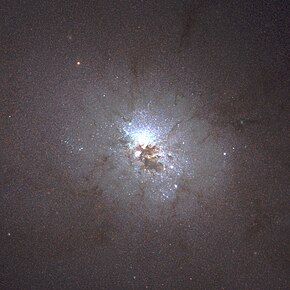
The M81 Group is a galaxy group in the constellations Ursa Major and Camelopardalis that includes the galaxies Messier 81 and Messier 82, as well as several other galaxies with high apparent brightnesses. The approximate center of the group is located at a distance of 3.6 Mpc, making it one of the nearest groups to the Local Group. The group is estimated to have a total mass of ×1012M☉. The M81 Group, the Local Group, and other nearby groups all lie within the Virgo Supercluster.
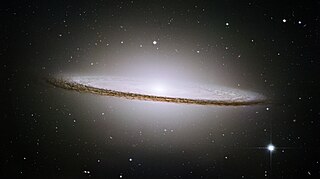
The Sombrero Galaxy is a peculiar galaxy of unclear classification in the constellation borders of Virgo and Corvus, being about 9.55 megaparsecs from the Milky Way galaxy. It is a member of the Virgo II Groups, a series of galaxies and galaxy clusters strung out from the southern edge of the Virgo Supercluster. It has an isophotal diameter of approximately 29.09 to 32.32 kiloparsecs, making it slightly bigger in size than the Milky Way.

NGC 404 is a field galaxy located about 10 million light years away in the constellation Andromeda. It was discovered by William Herschel in 1784, and is visible through small telescopes. NGC 404 lies just beyond the Local Group and does not appear gravitationally bound to it. It is located within 7 arc-minutes of second magnitude star Mirach, making it a difficult target to observe or photograph and granting it the nickname "Mirach's Ghost".

Messier 94 is a spiral galaxy in the mid-northern constellation Canes Venatici. It was discovered by Pierre Méchain in 1781, and catalogued by Charles Messier two days later. Although some references describe M94 as a barred spiral galaxy, the "bar" structure appears to be more oval-shaped. The galaxy has two ring structures.
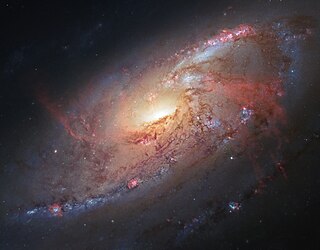
Messier 106 is an intermediate spiral galaxy in the constellation Canes Venatici. It was discovered by Pierre Méchain in 1781. M106 is at a distance of about 22 to 25 million light-years away from Earth. M106 contains an active nucleus classified as a Type 2 Seyfert, and the presence of a central supermassive black hole has been demonstrated from radio-wavelength observations of the rotation of a disk of molecular gas orbiting within the inner light-year around the black hole. NGC 4217 is a possible companion galaxy of Messier 106.
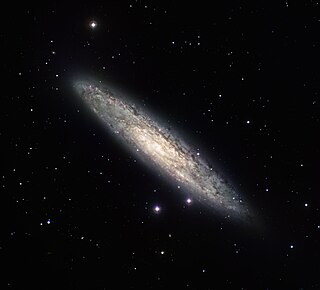
The Sculptor Galaxy is an intermediate spiral galaxy in the constellation Sculptor. The Sculptor Galaxy is a starburst galaxy, which means that it is currently undergoing a period of intense star formation.

NGC 891 is an edge-on unbarred spiral galaxy about 30 million light-years away in the constellation Andromeda. It was discovered by William Herschel on October 6, 1784. The galaxy is a member of the NGC 1023 group of galaxies in the Local Supercluster. It has an H II nucleus.
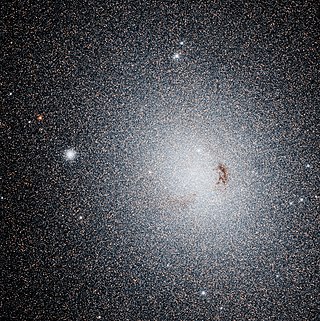
NGC 185 is a dwarf spheroidal galaxy located 2.08 million light-years from Earth, appearing in the constellation Cassiopeia. It is a member of the Local Group, and is a satellite of the Andromeda Galaxy (M31). NGC 185 was discovered by William Herschel on November 30, 1787, and he cataloged it "H II.707". John Herschel observed the object again in 1833 when he cataloged it as "h 35", and then in 1864 when he cataloged it as "GC 90" within his General Catalogue of Nebulae and Clusters. NGC 185 was first photographed between 1898 and 1900 by James Edward Keeler with the Crossley Reflector of Lick Observatory. Unlike most dwarf elliptical galaxies, NGC 185 contains young stellar clusters, and star formation proceeded at a low rate until the recent past. NGC 185 has an active galactic nucleus (AGN) and is usually classified as a type 2 Seyfert galaxy, though its status as a Seyfert is questioned. It is possibly the closest Seyfert galaxy to Earth, and is the only known Seyfert in the Local Group.
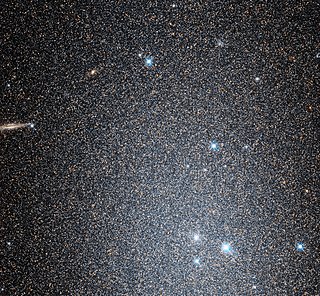
NGC 147 is a dwarf spheroidal galaxy about 2.58 Mly away in the constellation Cassiopeia. NGC 147 is a member of the Local group of galaxies and a satellite galaxy of the Andromeda Galaxy (M31). It forms a physical pair with the nearby galaxy NGC 185, another remote satellite of M31. It was discovered by John Herschel in September 1829. Visually it is both fainter and slightly larger than NGC 185. This means that NGC 147 is more difficult to see than NGC 185, which is visible in small telescopes. In the Webb Society Deep-Sky Observer's Handbook, the visual appearance of NGC 147 is described as follows:
Large, quite faint, irregularly round; it brightens in the middle to a stellar nucleus.
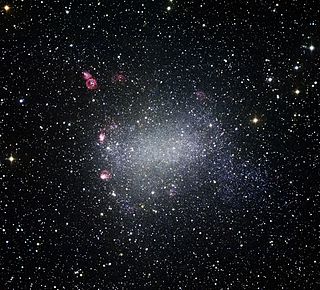
NGC 6822 is a barred irregular galaxy approximately 1.6 million light-years away in the constellation Sagittarius. Part of the Local Group of galaxies, it was discovered by E. E. Barnard in 1884, with a six-inch refractor telescope. It is the closest non-satellite galaxy to the Milky Way, but lies just outside its virial radius. It is similar in structure and composition to the Small Magellanic Cloud. It is about 7,000 light-years in diameter.

IC 342 is an intermediate spiral galaxy in the constellation Camelopardalis, located relatively close to the Milky Way. Despite its size and actual brightness, its location behind dusty areas near the galactic equator makes it difficult to observe, leading to the nickname "The Hidden Galaxy", though it can readily be detected even with binoculars. If the galaxy were not obscured, it would be visible by naked eye. The dust makes it difficult to determine its precise distance; modern estimates range from about 7 million light-years (Mly) to about 11 Mly. The galaxy was discovered by William Frederick Denning in 1892. It is one of the brightest in the IC 342/Maffei Group, one of the closest galaxy groups to the Local Group. Edwin Hubble first thought it to be in the Local Group, but it was later determined not to be a member.

NGC 1316 is a lenticular galaxy about 60 million light-years away in the constellation Fornax. It is a radio galaxy and at 1400 MHz is the fourth-brightest radio source in the sky.

NGC 2683 is a field spiral galaxy in the northern constellation of Lynx. It was nicknamed the "UFO Galaxy" by the Astronaut Memorial Planetarium and Observatory. It was discovered by the astronomer William Herschel on February 5, 1788.
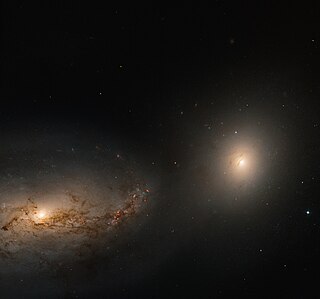
NGC 3227 is an intermediate spiral galaxy that is interacting with the dwarf elliptical galaxy NGC 3226. The two galaxies are one of several examples of a spiral with a dwarf elliptical companion that are listed in the Atlas of Peculiar Galaxies. Both galaxies may be found in the constellation Leo. It is a member of the NGC 3227 Group of galaxies, which is a member of the Leo II Groups, a series of galaxies and galaxy clusters strung out from the right edge of the Virgo Supercluster.

NGC 5102, also known as Iota's Ghost, is a lenticular galaxy in the Centaurus A/M83 Group of galaxies. It was discovered by John Herschel in 1835.

The Bubble Nebula in Barnard's Galaxy has the official designation of Hubble 1925 I as it was the first object recorded in a paper by Hubble 1925. It includes areas of bright H II emission. It is located north-west of the larger Hubble 1925 III.

The Antlia Dwarf is a dwarf spheroidal/irregular galaxy. It lies about 1.3 Mpc from Earth in the constellation Antlia. It is the fourth and faintest member of the nearby Antlia-Sextans Group of galaxies. The galaxy contains stars of all ages, contains significant amounts of gas, and has experienced recent star formation. The Antlia Dwarf is believed to be tidally interacting with the small barred spiral galaxy NGC 3109.

NGC 4236 is a barred Magellanic spiral galaxy located in the constellation Draco.
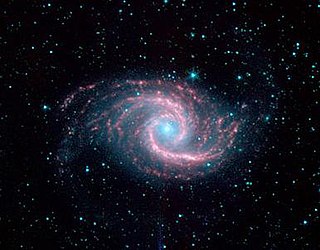
The Dorado Group is a loose concentration of galaxies containing both spirals and ellipticals. It is generally considered a 'galaxy group' but may approach the size of a 'galaxy cluster'. It lies primarily in the southern constellation Dorado and is one of the richest galaxy groups of the Southern Hemisphere. Gérard de Vaucouleurs was the first to identify it in 1975 as a large complex nebulae II in the Dorado region, designating it as G16.

NGC 3489 is a lenticular galaxy located in the constellation Leo. It is located at a distance of about 30 million light years from Earth, which, given its apparent dimensions, means that NGC 3489 is about 30,000 light years across. It was discovered by William Herschel on April 8, 1784. NGC 3489 is a member of the Leo Group.
